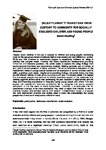(Re)Settlement? Transitions from Custody to Community for Socially Excluded Children and Young People
| dc.contributor.author | Hocking, Sarah | |
| dc.date.accessioned | 2017-03-29T10:50:30Z | |
| dc.date.accessioned | 2017-04-11T11:30:16Z | |
| dc.date.available | 2017-03-29T10:50:30Z | |
| dc.date.available | 2017-04-11T11:30:16Z | |
| dc.date.issued | 2014 | |
| dc.identifier.citation |
Hocking, S. (2014) 'Re)Settlement? Transitions from Custody to Community for Socially Excluded Children and Young People', Plymouth Law and Criminal Justice Review, 6, pp. 192-213. Available at: https://pearl.plymouth.ac.uk/handle/10026.1/8998 | en_US |
| dc.identifier.issn | 2054-149X | |
| dc.identifier.uri | http://hdl.handle.net/10026.1/8998 | |
| dc.description.abstract |
Despite recent declines in the use of custody for children and young people, reoffending rates for this age group remain notoriously high at over seventy per cent (Ministry of Justice, 2013) and their aftercare or resettlement support is consistently criticised for failing to address their complex needs. However with recent resettlement developments promising ‘enhanced’ and intensive provision, this article seeks to explore this using findings from semi-structured interviews and documentary analysis. Making particular use of Levitas et al.’s (2007) conceptualisation of social exclusion, this article provides a discussion of the resettlement needs of young custody leavers and an evaluation of current provision and its ability to address such needs. Despite some promising findings, the article shows that there are still inherent failures to meet all young people’s complex inclusionary needs. It is argued this is because programmes continue to provide superficial support in ‘job readiness’ and tackling cognitive deficits rather than addressing the poor structure of opportunities and the deep and interacting expressions of inequality facing young people who offend. It is also argued that resettlement attempts consistently fail to recognise that young people’s ‘settlement’ in the first place is highly questionable. Therefore, it is concluded that for resettlement attempts to be more successful, they need to adjust their mission to one of intensive inclusion and perhaps ‘starting from scratch’. Fundamentally though, it is argued that both resettlement attempts and society need to more fully acknowledge that young people who offend are in every sense children in need. | en_US |
| dc.language.iso | en | en_US |
| dc.publisher | University of Plymouth | |
| dc.rights | Attribution 4.0 International (CC BY 4.0) | * |
| dc.rights.uri | https://creativecommons.org/licenses/by/4.0/ | * |
| dc.subject | youth justice | en_US |
| dc.subject | desistance | en_US |
| dc.subject | resettlement | en_US |
| dc.subject | social exclusion | en_US |
| dc.title | (Re)Settlement? Transitions from Custody to Community for Socially Excluded Children and Young People | en_US |
| dc.type | Article | en_US |
| dc.type | Article | |
| plymouth.volume | 6 | |
| plymouth.journal | The Plymouth Law & Criminal Justice Review |



